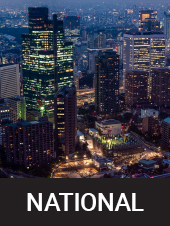Prime Minister Mark Carney called new 25 per cent tariffs set to be imposed by U.S. President Donald Trump on all vehicles made outside the U.S. next month a “direct attack” on Canadian workers.

“We will defend our workers, we will defend our companies, we will defend our country and we will defend it together,” Carney said Wednesday evening.
Trump announced the latest set of tariffs, signing an executive order that will see a 25 per cent tariff imposed on foreign-made cars and light trucks, in addition to tariffs already in place on those goods.
Trump called the auto tariffs the “beginning of Liberation Day in America,” before going on to claim that they were losing U.S. plants to Mexico, Canada and other places.
“We’ll effectively be charging a 25 per cent tariff, but if you build your car in the United States, there’s no tariff,” Trump said. “We’re signing today, it goes into effect April 2, we start collecting April 3.”
Asked if there would be a possibility of removing the duties in the future if conditions are met, Trump said the tariffs were “permanent, 100 per cent.”
He added that it would apply to all countries, but said they would be “very lenient” for some, though did not go into further detail.

Carney, who spoke from the campaign trail where he is running as the Liberal leader but also retains caretaker responsibilities as the current prime minister, had been making an announcement earlier in the day at the Ambassador Bridge, a structure he called a symbol of the “tight ties” between the two countries.
“Ties of kinship, ties of commerce, ties that are in the process of being broken,” he said. “This will hurt us but through this period by being together, we will emerge stronger.”
The prime minister said even in a caretaker period, his team had anticipated the possibility of tariffs and planned to meet with his cabinet to discuss potential retaliatory actions.
“We will take steps that are in the interests of Canadian workers,” Carney said, adding he will be returning to Ottawa Wednesday night for a cabinet meeting to discuss responses on Thursday. “We’ll fight in a unified way.”
He said as his team did not have the full details of the executive order, they need to wait to determine how the tariffs will apply, including whether they would hit part components of a vehicle or if it would be on the entirety of the vehicle.
Regardless of whether it is a part or full vehicle, Carney said the actions by Trump are “entirely unjustified.”
Conservative Leader Pierre Poilievre said the tariffs were “unjustified and unprovoked” and would hurt the U.S. economy. NDP Leader Jagmeet Singh called Trump’s tariffs a “full-frontal attack” on auto workers.
“This is a direct attack on our workers and we’ve got to fight back like hell. We’ve got to fight back with retaliatory tariffs,” Singh said.
“Trump is an arsonist. He’s literally burning down his own country’s jobs and economy, and ours as well.”
Those tariffs on the auto sector, which is already dealing with the impact of 25 per cent duties on steel and aluminum, could have a further impact as consumers also grapple with the broader set of 25 per cent tariffs imposed at the start of March on all Canadian and Mexican goods.
The tariffs will likely hit Ontario the hardest if they take effect as planned on April 2. Both the federal and provincial governments have poured tens of billions of dollars into the auto industry.

Get breaking National news
Flavio Volpe, the president of the Automotive Parts Manufacturers’ Association, said the new policy was confusing and damaging.
“I have never heard something less clear or based in fact in my life,” he wrote in a social media post.
“China could only dream of damaging the American auto industry so quickly and so decisively as what Trump is threatening to do here again.”
In a response posted to social media, Ontario Premier Doug Ford said Trump was “at it again” with the new tariffs.
“His 25 per cent tariffs on cars and light trucks will do nothing more than increase costs for hard-working American families,” Ford wrote.
“U.S. markets are already on the decline as the president causes more chaos and uncertainty. He’s putting American jobs at risk.”

Ford said he had spoken to Carney and said the federal government was “preparing” retaliatory tariffs.
The Canadian Chamber of Commerce criticized the move by Trump, saying in a statement the escalation in “this destructive tariff war” would not be contained to Canada.
“Throwing away tens of thousands of jobs on both sides of the border will mean giving up North America’s auto leadership role, instead encouraging companies to build and hire anywhere else but here,” the statement reads. “This tax hike puts plants and workers at risk for generations, if not forever.”
Ford took a swipe at Trump’s claim April 2 would be “liberation day” in the United States.
“I call it termination day for American workers,” Ford said. “I know President Trump likes telling people ‘You’re fired,’ I didn’t think he meant auto workers in the U.S. when he said that.”
Ford’s province has seen massive investment from the federal and provincial governments into the auto industry.
Over the past few years, Ford and then-prime minister Justin Trudeau announced construction aid and tax-relief subsidies to tempt companies like Volkswagen, Stellantis and Ford Motors to anchor electric vehicle operations and battery plants in the province.
The companies which settled on Ontario to house their operations rely on parts manufacturers and assembly lines on both sides of the U.S.-Canada border.
When Trump first announced his tariffs on vehicles, Ford suggested the assembly lines wouldn’t last much longer than a week before being forced to close.
“Assembly lines and the auto sector will shut down within 10 days, I predict. Hopefully they won’t, but I’m predicting they’ll shut down because of the trade that we do back and forth,” Ford said at the beginning of March.
“Parts, as you’ve heard many times, go back and forth up to eight times, each time hitting a 25 per cent tariff on both sides of the border. I am almost positive the assembly plants will shut down on both sides of the border.”
A total of five major auto manufacturers — Ford, General Motors, Honda, Stellantis, Toyota — already call Ontario home, along with 350 parts manufacturers and future commitments from other car companies.
In 2023, 30 per cent of Ontario’s exports were vehicles or auto parts. The figure amounts to $68 billion.

During the recent Ontario election, Ford promised he would support areas like Windsor, Ont., if tariffs did hit. His party promised to open triage centres for workers who were laid off and pour money into retraining.
Ford had separately worried about Trump’s attempts to take jobs from Ontario.
At the beginning of March, the day after introducing auto tariffs, Trump paused them, citing his desire not to hurt American companies in the U.S.-Canada trade war.
The premier said that the move was not a blessing but a bigger threat.
“I always worry when someone says 30-day reprieve that gives them a chance to start lining things up and planning their next move,” Ford said on March 5. “As we all know, what the president says today may change tomorrow. We’ve seen this pattern; the goalposts change constantly.”
Trump was also questioned Wednesday about reaction by the Big Three automakers — Stellantis, Ford and General Motors — whose calls with the president early in March prompted a pause on the implementation of the tariffs, which had been set to kick in weeks ago.
“I can tell you if they have factories here, they’re thrilled if you don’t have factories here, they’re going to have to get going and build them because otherwise they have to pay tariffs,” he told reporters.
Ford caught the attention – and ire — of Trump in mid-March when he briefly levied a 25 per cent surcharge on energy exported to the United States.

At the time, Ford ordered the province’s energy agency to levy a charge of 25 per cent on all energy sold by Ontario to Michigan, Minnesota and New York. Trump responded by threatening to double tariffs on all Canadian steel and aluminum from the already planned 25 per cent to 50 per cent.
That retaliatory measure lasted less than 48 hours and secured Ford a meeting in Washington, D.C., with Trump’s commerce secretary.
During that meeting, Ford said he was promised there would be better from the U.S. and that Ontario would get a heads up before new economic measures.
That heads up didn’t come, Ford said on Thursday.
“We thought we’d be informed, the word ‘no surprises’ came up in the meeting, ” the premier told reporters. “And sure enough, there’s a surprise. I honestly believe the American administration some days can’t predict what President Trump is going to say.”
Unlike his decision to levy an electrical surcharge, which appeared to be a decision Ontario made alone, Ford said on Thursday he wanted to approach the new threat together.
“I want to take a Team Canada approach, I do not want to hurt other provinces,” Ford said. “But I can assure you one thing, we’re going to make sure we inflict as much pain as possible on the American people, without inflicting pain on the Canadian population.”
Alberta and Saskatchewan have both recently deviated from Ontario’s stance on tariff responses.
Ford, who chairs the Council of the Federation, said he wanted the first ministers and Carney to meet by Monday.
Ford said economic stimulus — potentially federal and provincial — would be ready by April 2 if the tariffs do take effect.









Comments